Organic Pesticides Market Size - Global Industry, Share, Analysis, Trends and Forecast 2022 - 2030
Published :
Report ID:
Pages :
Format :
Organic Pesticides Market Size - Global Industry, Share, Analysis, Trends and Forecast 2022 - 2030
Report Coverage
- Industry Dynamics
- Market Size and Forecast Data
- Segment Analysis
- Competitive Landscape
- Regional Analysis with a Niche Focus on Country-Level Data
- High Level Analysis - Porter's, PESTEL, Value Chain, etc.
- Company Profiles of Key Players
- Option to Customize the Report As Per Your Specific Need
Request Sample Report
The Global Organic Pesticides Market Size gathered USD 226.3 Billion in 2021 and is set to garner a market size of USD 631.4 Billion by 2030 growing at a CAGR of 12.3% from 2022 to 2030.
Organic pesticides are substances derived from natural sources, such as plants or minerals, and are used in organic farming to control pests. Neem oil, pyrethrin, and rotenone are examples of organic pesticides. Organic pesticides, as opposed to synthetic pesticides, which are frequently derived from petrochemicals, are thought to be less toxic and more environmentally friendly. However, "organic" does not always imply "non-toxic" or "harmless," and some organic pesticides can still be harmful to non-target species and the environment.
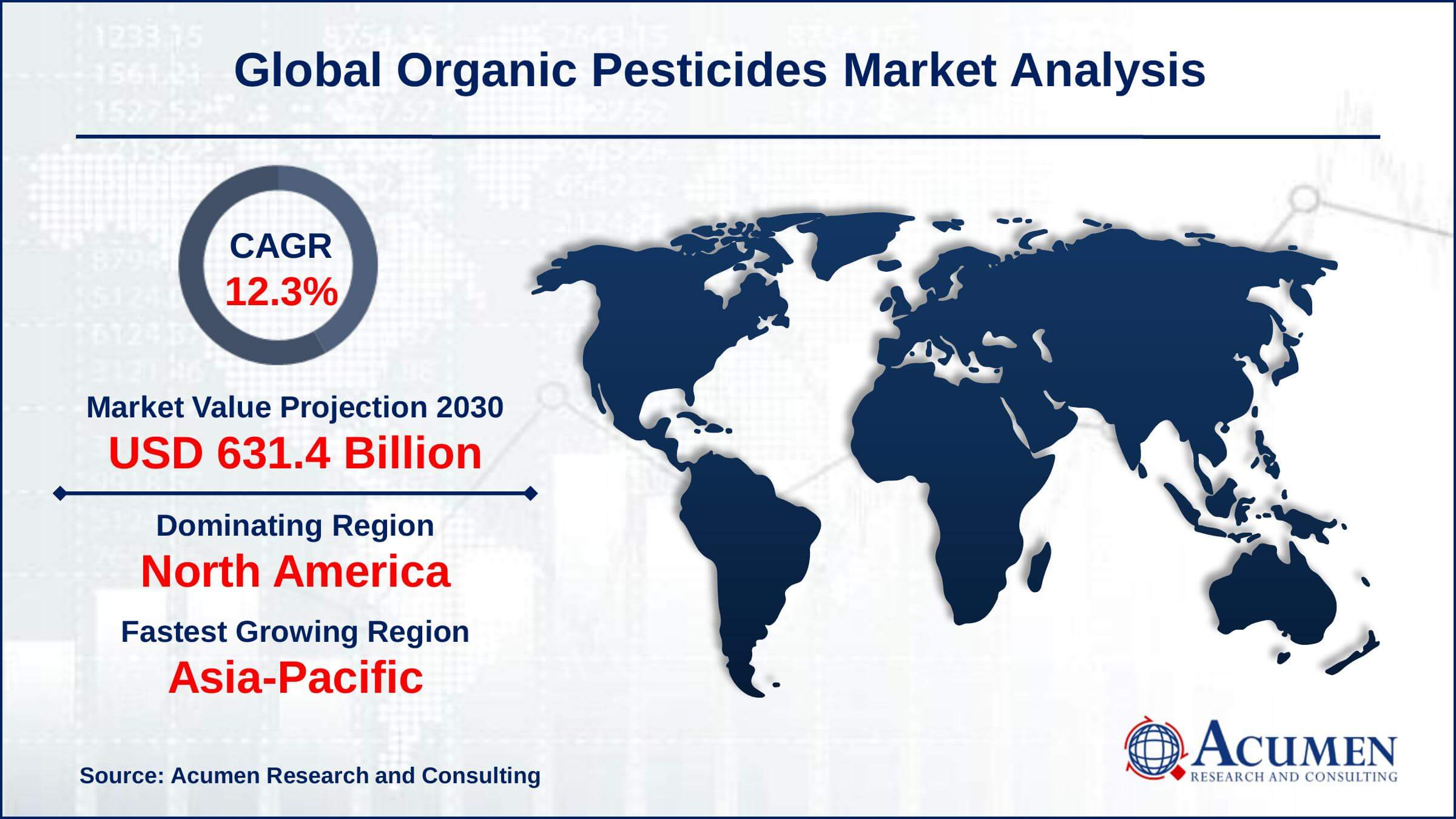
Organic Pesticides Market Report Statistics
- Global organic pesticides market revenue is estimated to reach USD 631.4 Billion by 2030 with a CAGR of 12.3% from 2022 to 2030
- North America organic pesticides market value gathered more than USD 81.5 billion in 2021
- Asia-Pacific organic pesticides market growth will record a CAGR of more than 13% from 2022 to 2030
- Based on product type, the natural sub-segment achieved over 64% of the share in 2021
- Among crop types, the arable stores sub-segment collected revenue of around US$ 174.3 billion in 2021
- The growing advancement in farming technology is a popular organic pesticides market trend that drives the industry demand
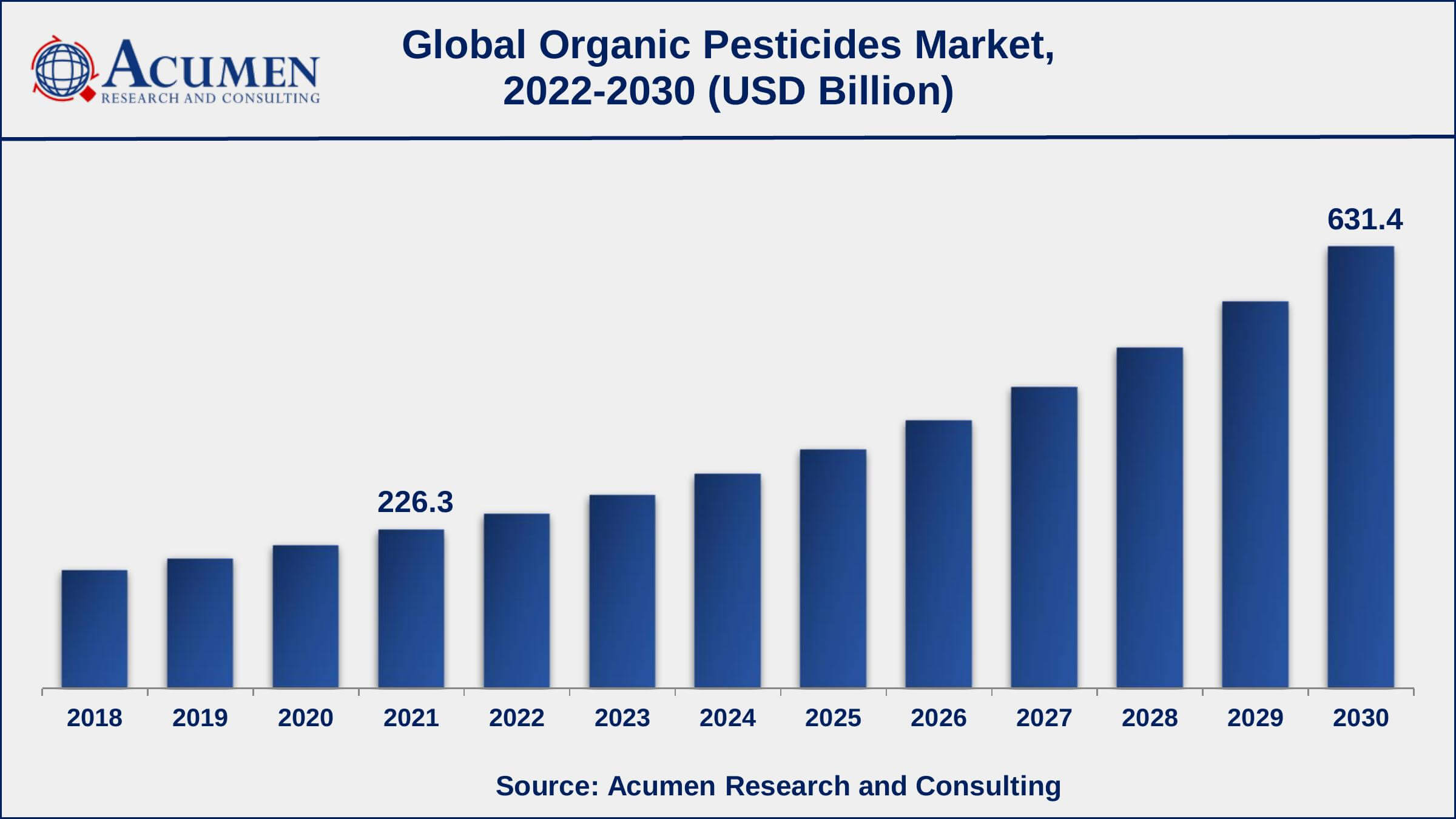
Global Organic Pesticides Market Dynamics
Market Drivers
- Growing consumer demand for organic products
- Rapid adoption of organic farming
- Increasing awareness about the benefits of organic farming
- Strict regulations for inorganic products
Market Restraints
- High cost of these pesticides
- Limited availability
Market Opportunities
- Favorable support from government organizations
- Rising trend of e-commerce and online sales
Organic Pesticides Market Report Coverage
| Market | Organic Pesticides Market |
| Organic Pesticides Market Size 2021 | USD 226.3 Billion |
| Organic Pesticides Market Forecast 2030 | USD 631.4 Billion |
| Organic Pesticides Market CAGR During 2022 - 2030 | 12.3% |
| Organic Pesticides Market Analysis Period | 2018 - 2030 |
| Organic Pesticides Market Base Year | 2021 |
| Organic Pesticides Market Forecast Data | 2022 - 2030 |
| Segments Covered | By Product Type, By Crop Type, By Application, And By Geography |
| Regional Scope | North America, Europe, Asia Pacific, Latin America, and Middle East & Africa |
| Key Companies Profiled | Andermatt Biocontrol Ag, Arysta Lifescience, Bayer Cropscience, Certis USA L.L.C., Dow Agrosciences, Dupont, Mark Organic, Monsanto, Parry America, and Sikko Industry Ltd. |
| Report Coverage |
Market Trends, Drivers, Restraints, Competitive Analysis, Player Profiling, Covid-19 Analysis, Regulation Analysis |
Organic Pesticides Market Growth Factors
One of the major factors driving the global organic pesticide market value is an increase in consumer demand for organic products. Organic product demand, including food and non-food items, is rising globally as consumers become more aware of the dangers of chemical pesticides to their health and the environment. Furthermore, government support and regulations are important factors driving the growth of the organic pesticide market. Many governments, for example, encourage the use of organic pesticides through policies and regulations that support organic farming, such as the provision of subsidies and financial aid. Growing public awareness of the benefits of organic farming drives up demand for organic pesticides. The growing awareness of the benefits of organic farming, such as improved soil health, biodiversity, and ecosystem services, is propelling the organic pesticides market forward.
The high cost of these pesticides, however, is impeding the market growth. Organic pesticides are generally more costly than synthetic pesticides, which can be prohibitively expensive for farmers on a tight budget. Besides that, their limited availability is a limiting factor that will create a roadblock to industry growth. On the other hand, e-commerce and online sales channels are expanding, making it easier for consumers to purchase organic pesticides and expanding market opportunities. Furthermore, organic farming practices are becoming more popular around the world, which is increasing the demand for organic pesticides and, as a result, the organic pesticides market.
Organic Pesticides Market Segmentation
The worldwide organic pesticides market is categorized based on product type, crop type, application, and geography.
Organic Pesticides Market By Product Type
- Natural
- Synthetic
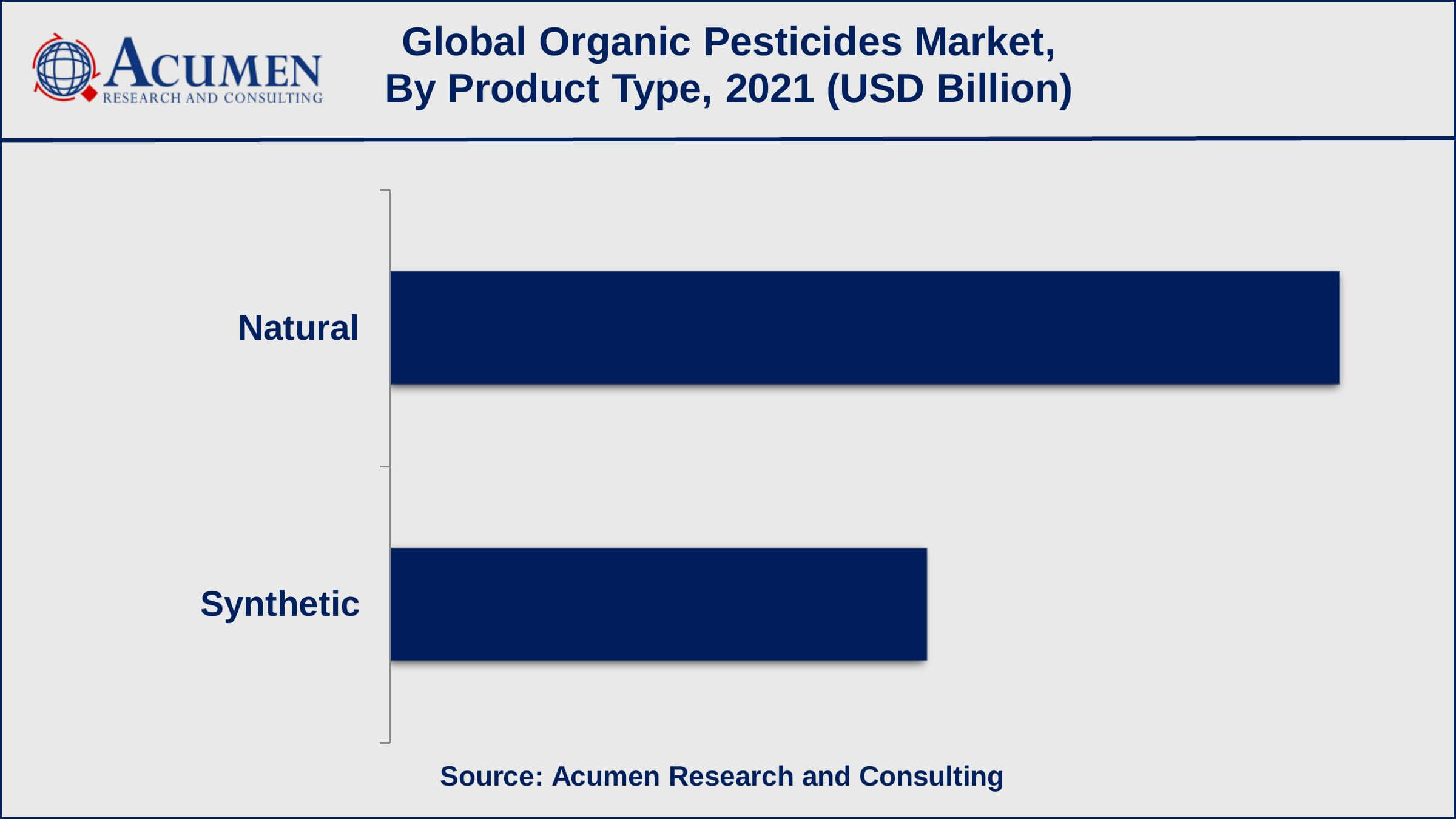
According to our organic pesticides industry analysis, the natural sub-segment will account for a sizable market share in 2021. Natural pesticides are becoming more popular as consumers become more aware of the dangers of chemical pesticides to the environment and their health. Natural pesticides are derived from natural materials such as plants and minerals and are less toxic and less harmful to the environment than synthetic pesticides. This growing consumer awareness and interest are driving the demand for natural pesticides. Furthermore, rising support from the government and regulations for organic farming, such as subsidies and financial assistance, as well as the growing trend of organic farming, are driving demand for natural pesticides.
Organic Pesticides Market By Crop Type
- Permanent
- Arable
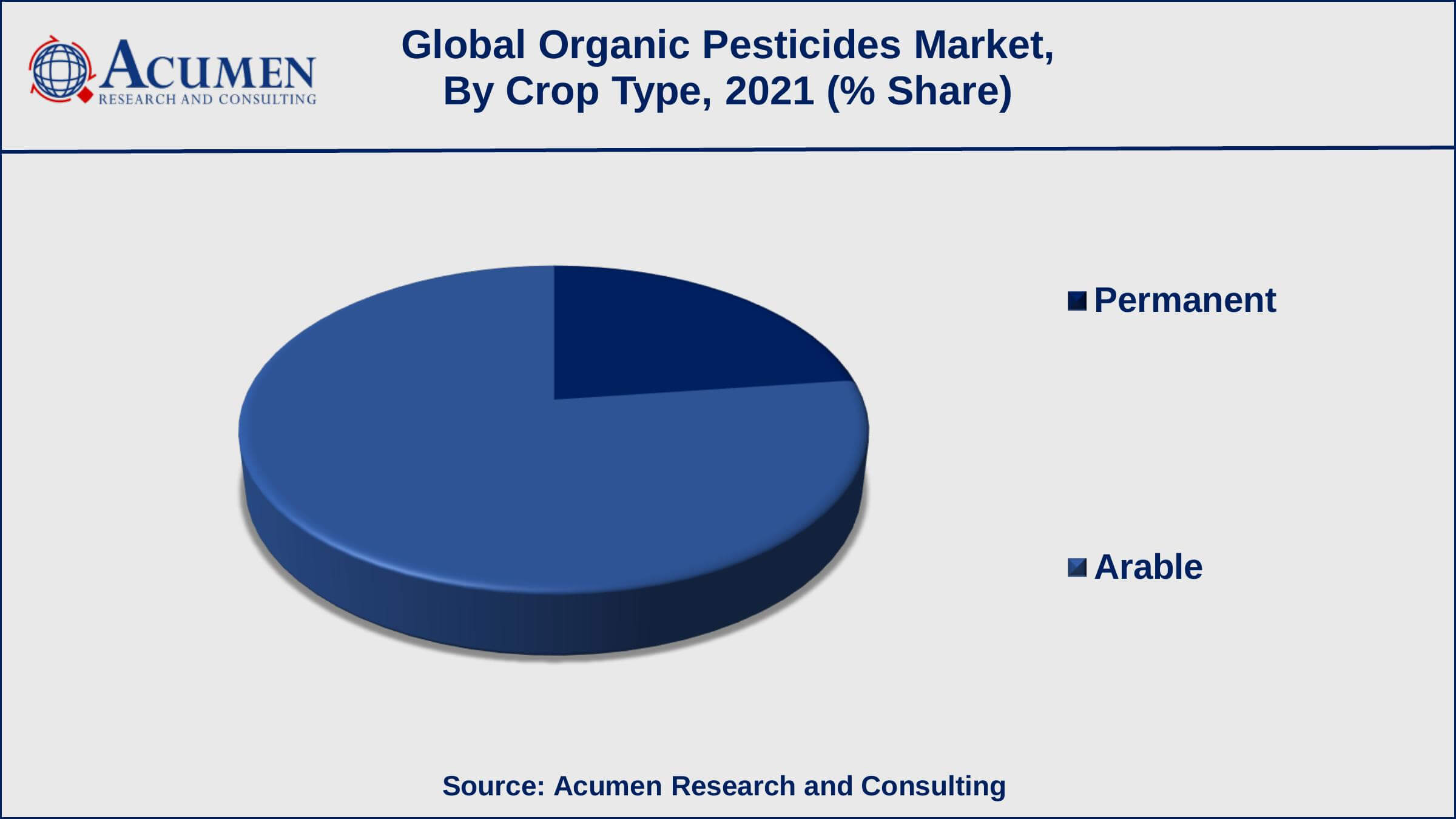
Based on crop type, the arable crop type sub-segment dominated the market in 2021 and is expected to continue to do so in the coming years. Organic pesticides can provide several benefits when used on arable crops, including reduced toxicity, improved soil health, and enhanced biodiversity. Arable land includes land used for temporary crops such as cereals, mowing or grazing meadows, market or kitchen gardens, and fallow land. During the forecast period, government policies encouraging the use of organic pesticides are expected to boost demand.
Organic Pesticides Market By Application
- Seed Treatment
- On Farm
- After Harvest
The organic pesticides market forecast predicts that the on-farm application sub-segment will account for a significant market share between 2022 and 2030. On-farm organic pesticides are becoming more popular around the world as farmers become more aware of the advantages of organic farming and the adverse effect of synthetic pesticides on human health and the environment. Organic pesticides produced and used on farms are known as on-farm pesticides. Organic pesticides are thought to be more environmentally friendly and sustainable than synthetic pesticides.
Organic Pesticides Market Regional Outlook
North America
- U.S.
- Canada
Europe
- U.K.
- Germany
- France
- Spain
- Rest of Europe
Asia-Pacific
- India
- Japan
- China
- Australia
- South Korea
- Rest of Asia-Pacific
Latin America
- Brazil
- Mexico
- Rest of Latin America
The Middle East & Africa
- South Africa
- GCC Countries
- Rest of the Middle East & Africa (ME&A)
Organic Pesticides Market Regional Analysis
According to our regional analysis, North America generated the most revenue in 2021 and is expected to lead in the years ahead, from 2022 to 2030. The organic pesticides market in North America is being driven by rising demand for organic products as well as increased awareness of the benefits of organic farming. The United States is the region's largest contributor to market growth. In terms of growth, the Asia-Pacific region is expected to experience the fastest growth rate between 2022 and 2030. The Asia Pacific organic pesticides market is being driven by the increasing adoption of organic farming practices, rising awareness about the benefits of organic products, and the region's growing population. China, India, and Japan are the major contributors to the market growth in the region.
Organic Pesticides Market Players
Some of the leading organic pesticides companies include Andermatt Biocontrol Ag, Bayer Cropscience, Arysta Lifescience, Dow Agrosciences, Parry America, Certis USA L.L.C., Mark Organic, Dupont, Monsanto, and Sikko Industry Ltd.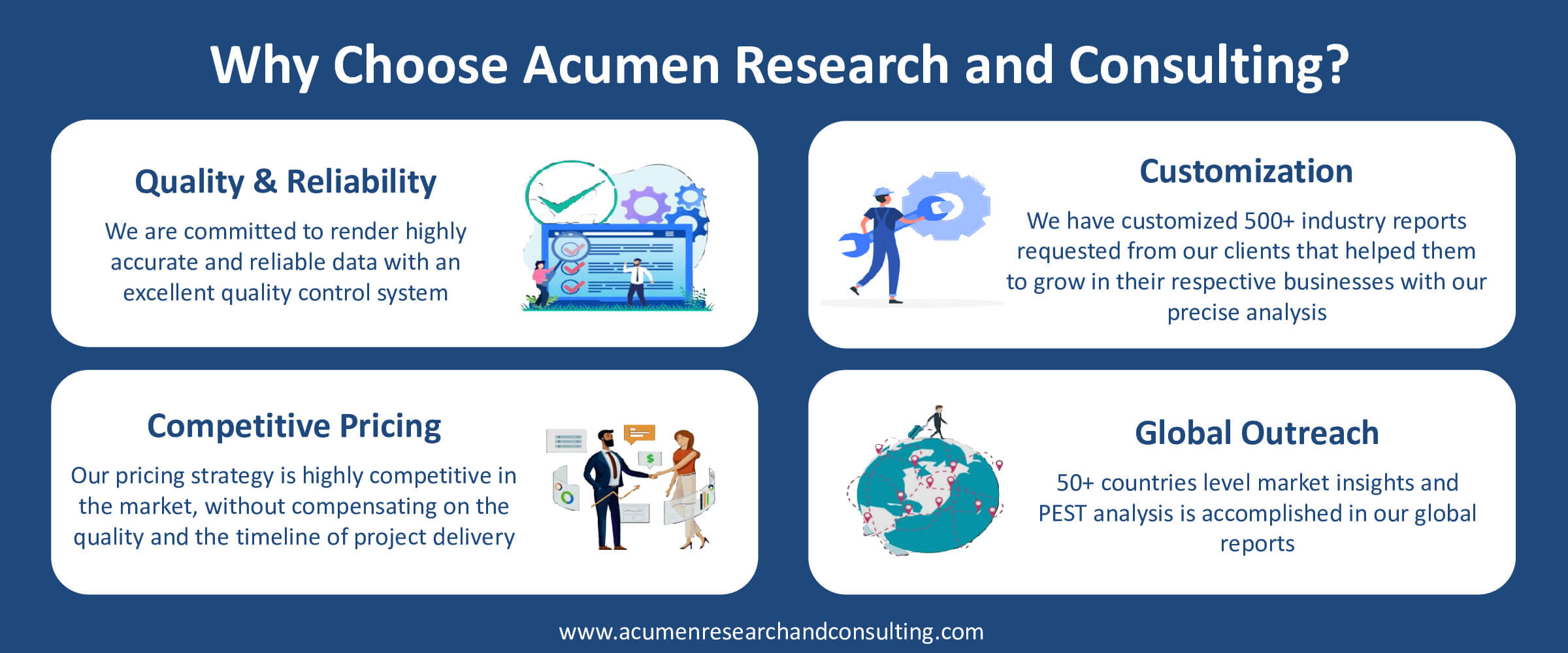
Frequently Asked Questions
What was the market size of the global organic pesticides in 2021?
The market size of organic pesticides was USD 226.3 Billion in 2021.
What is the CAGR of the global organic pesticides market during forecast period of 2022 to 2030?
The CAGR of organic pesticides market is 12.3% during the analysis period of 2022 to 2030.
Which are the key players operating in the market?
The key players operating in the global organic pesticides market are Andermatt Biocontrol Ag, Arysta Lifescience, Bayer Cropscience, Certis USA L.L.C., Dow Agrosciences, Dupont, Mark Organic, Monsanto, Parry America, and Sikko Industry Ltd.
Which region held the dominating position in the global organic pesticides market?
North America held the dominating position in organic pesticides market during the analysis period of 2022 to 2030.
Which region registered the fastest growing CAGR for the forecast period of 2022 to 2030?
Asia-Pacific region exhibited fastest growing CAGR for organic pesticides market during the analysis period of 2022 to 2030.
What are the current trends and dynamics in the global organic pesticides market?
The current trends and dynamics in the organic pesticides industry include growing consumer demand for organic products, rapid adoption of organic farming, and increasing awareness about the benefits of organic farming.
Which product type held the maximum share in 2021?
The natural product type held the maximum share of the organic pesticides market.



